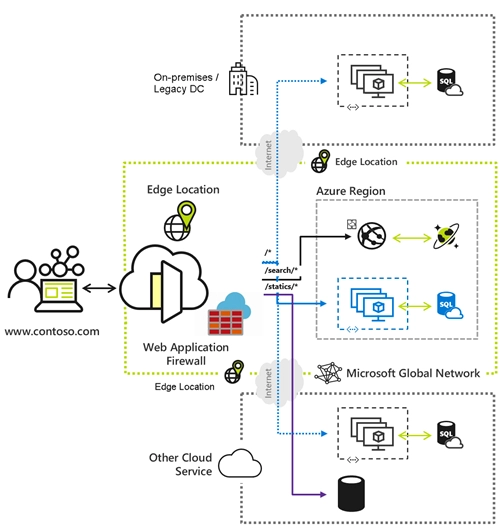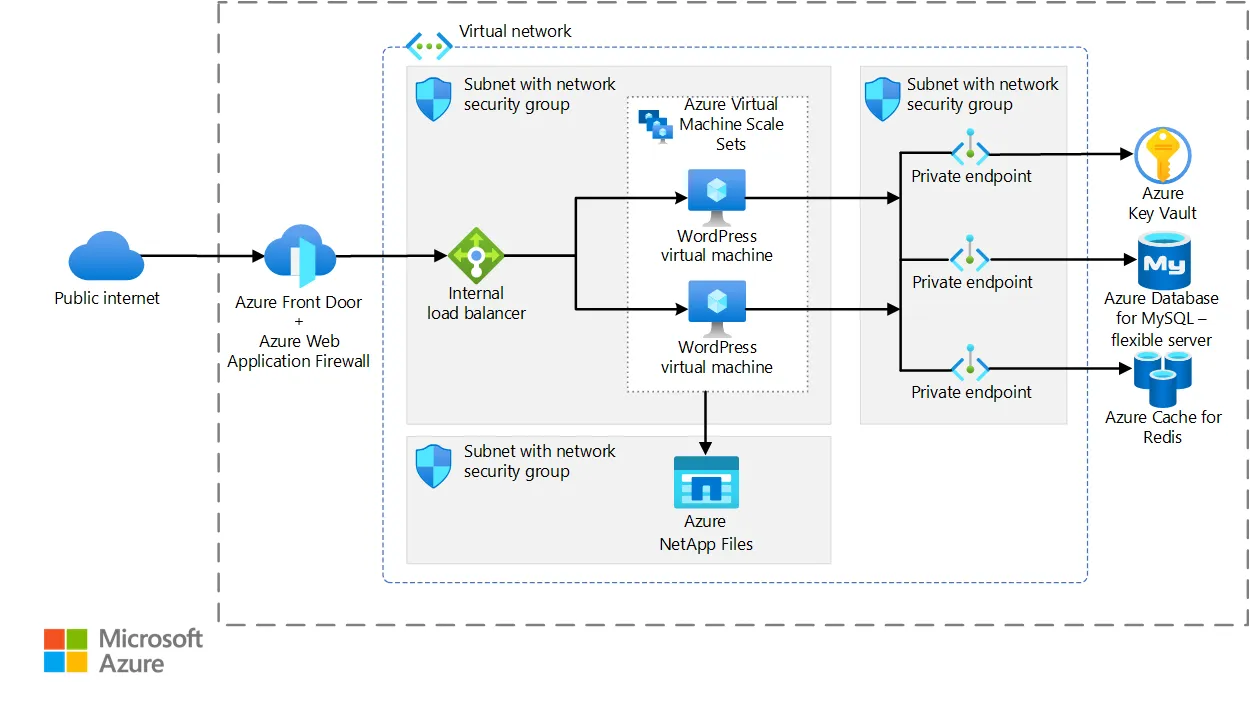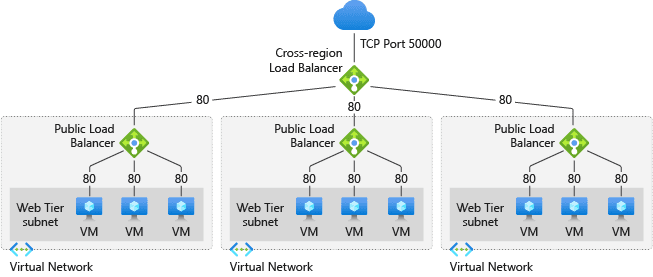Azure Load Balancing Solutions: When to Use Front Door, Traffic Manager, Application Gateway, or Load Balancer
Introduction
Hello Everyone! Welcome back from ARTIFICALAB LTD! Today, we will be discussing about the different varieties of load balancing solutions, provided by Microsoft Azure Cloud platform. Indeed, choosing the right load-balancing option could be challenging since the requirements, and the expertise of each application can vary!
Anyway, today we will share the available load-balancing solutions in Azure Cloud, as well as in which scenarios and situations it is perfect to use! Thus, we will explore four key Azure load balancing services: Azure Front Door, Azure Traffic Manager, Azure Application Gateway, and Azure Load Balancer. We’ll discuss their features, use cases, and when to use each one, categorized by global vs. regional and HTTP(S) vs. non-HTTP(S) traffic.
So, let's get started!

"For new learners or for professional cloud architects, it is wise to understand the main differences between each available Azure Load-Balancer, and their recommend scenarios. Microsoft Azure has provided everything in a way that it's clients will be secured to server customers, anywhere over the world!"
— Mr. Thu Ta Naing, Founder & CEO (ARTIFICALAB LTD)
What is Load-Balancing in Azure Cloud?
In the Azure cloud, load balancing refers to distributing workloads across multiple computing resources to optimize resource use, maximize throughput, minimize response time, and avoid overloading any single resource.

Figure: A typical load-balancing solution in Azure, Image courtesy of Microsoft Azure
Categorization of Azure Load-Balancing Solutions
Generally, we can categorize the Azure Load Balancing into two criteria: Global vs Regional, and HTTP(S) vs non-HTTP(S).
Global vs. Regional:
Global: These services distribute traffic across regional back-ends, clouds, or hybrid on-premises services. They manage a single control plane responsible for globally routing end-user traffic to an available back-end.
Regional: These services distribute traffic within virtual networks across virtual machines (VMs) or zonal and zone-redundant service endpoints within a region.
HTTP(S) vs. Non-HTTP(S):
HTTP(S): These are Layer 7 load balancers that only accept HTTP(S) traffic, intended for web applications or other HTTP(S) endpoints.
Non-HTTP(S): These are Layer 4 load balancers that handle non-HTTP(S) traffic, primarily TCP or UDP services.
Now, in next section, we shall explore the four types of Azure Load Balancing Services that every Azure Cloud Architect must know! So if you wanna become a Cloud Architect one day, you should check it out as follows!
Four Types of Azure Load Balancing Services we need to know!
1. Azure Front Door
Azure Front Door is a global, scalable entry point that uses the Microsoft global edge network to create fast, secure, and highly available web applications. It can provide application layer (HTTP/HTTPS) load balancing and can also offer numerous features such as SSL offloading, URL-based routing, and web application firewall (WAF) capabilities.
Indeed, Azure Front Door is the most modern cloud Content Delivery Network (CDN) ever that could provide fast, reliable, and secure access between your users and your applications’ static and dynamic web content across the globe.
This is because, related with the following diagram, there are already hundreds of global and local points of presence (PoPs) deployed all over the world to serve customers with low latency and fast response as much as possible!

Figure: Azure Front Door, Image courtesy of Microsoft Azure
Then, here is the some tip. According to Microsoft sources, for traffic handling on web applications, Microsoft recommends a combination of utilizing Azure DDoS protection and a web application firewall to safeguard against emerging DDoS attacks.
However, there is another option as well you can use. Deploy Azure Front Door with Azure Web Application Firewall, since Azure Front Door can handle platform-level protection against network-level DDoS attacks.
Then, what are the key features of Azure Front Door?
These are the key features in brief you should know about Azure Front Door!
-
Global load balancing with instant failover:
-
SSL offloading and certificate management
-
URL-based routing and path-based routing
-
Web Application Firewall (WAF) integration
-
Custom domain and SSL support
However, there's more many to cover about Azure Front Door. For that, we will cover you in a new separate article blog specifically on the Azure Front Door!

Figure: Azure Front Door, Image courtesy of Microsoft Azure
Real-World Use Cases of Azure Front Door!
- Applications that require global reach and low latency
- Web applications needing advanced routing and security features
- Scenarios where SSL offloading is beneficial
Thus, we suggest you to use Azure Front Door when you need a global load balancing solution with advanced routing capabilities and integrated security features. It’s really ideal for applications that serve a global audience and require high availability and performance.
However, there's another 3 solutions left, and let's check out them too!
2. Azure Traffic Manager
The next load-balancing solution we should focus on is the Azure Traffic Manager. Indeed, they are similar to each other in terms of functionalities and features, however, the application of these services will vary depending on the load-balancing usage and scenarios of the business systems!
Indeed, Azure Traffic Manager is a DNS-based traffic load balancer that distributes traffic across multiple endpoints, such as Azure VMs, web apps, and cloud services. It operates at the DNS level and provides various routing methods, including priority, weighted, performance, and geographic routing.
In this article, we will show you four types of traffic-routing method that the Azure Traffic Manager can handle! Indeed, this is very essential and important to new learners. So let's see!
-
Priority traffic-routing method
-
Weighted traffic-routing method
-
Performance traffic-routing method
-
Geographic traffic-routing method
Priority traffic-routing method
Weighted traffic-routing method

Figure: Azure Traffic Manager (priority traffic-routing), Image courtesy of Microsoft Azure

Figure: Azure Traffic Manager (priority traffic-routing), Image courtesy of Microsoft Azure
Performance traffic-routing method
Geographic traffic-routing method

Figure: Azure Traffic Manager (performance traffic-routing), Image courtesy of Microsoft Azure

Figure: Azure Traffic Manager (geographic traffic-routing), Image courtesy of Microsoft Azure
Then, what are the key features of Azure Traffic Manager?
We have attached some key features in brief you should know about Azure Traffic Manager!
- DNS-based load balancing
- Multiple routing methods (priority, weighted, performance, geographic)
- Endpoint health monitoring and automatic failover
- Integration with Azure and external endpoints
Real-World Use Cases of Azure Traffic Manager!
- Distributing traffic across multiple Azure regions
- Ensuring high availability by routing traffic to healthy endpoints
- Optimizing performance by directing users to the closest endpoint
The main point of Azure Traffic Manager is to route and distribute the traffic based on the rules set accordingly as above! Therefore, this is essential when you need to distribute traffic across multiple regions or endpoints and require DNS-level load balancing. It’s suitable for scenarios where you need to ensure high availability and optimize performance based on user location.
3. Azure Application Gateway
Azure Application Gateway is a web traffic load balancer that operates at the application layer (OSI layer 7). It provides features such as SSL termination, URL-based routing, session affinity, and WAF capabilities. Application Gateway is designed for web applications and offers deep integration with Azure services.

Figure: Azure Application Gateway, Image courtesy of Microsoft Azure

Figure: How Azure Application Gateway Works, Image courtesy of Microsoft Azure
Then, what are the key features of Azure Application Gateway?
These are the key features in brief you should know about Azure Application Gateway!
- Application layer (HTTP/HTTPS) load balancing
- SSL termination and certificate management
- URL-based routing and path-based routing
- Session affinity (sticky sessions)
- Web Application Firewall (WAF) integration
Real-World Use Cases of Azure Application Gateway
- Web applications requiring advanced routing and security features
- Scenarios where SSL termination and session affinity are needed
- Applications that benefit from WAF protection
Thus, it is wise to use Azure Application Gateway when you need application layer load balancing with advanced routing and security features. It’s ideal for web applications that require SSL termination, session affinity, and WAF capabilities.
4. Azure Load Balancer
The last one we going to discuss about is the Azure Load Balancer. Indeed, Azure Load Balancer is a network layer (OSI layer 4) load balancer that distributes incoming traffic among healthy instances of services in a load-balanced set. It provides high availability and network performance for your applications and supports both inbound and outbound scenarios.

Figure: How Azure Internal Load Balancer, Image courtesy of Microsoft Azure

Figure: How Azure Public Load Balancer, Image courtesy of Microsoft Azure
Then, what are the key features of Azure Load Balancer?
These are the key features in brief you should know about Azure Load Balancer!
- Network layer (TCP/UDP) load balancing
- High availability and scalability
- Health probes to monitor endpoint health
- Support for both public and internal load balancing
Practical Use Cases of Azure Load Balancer?
- Distributing traffic across VMs or services within a region
- Ensuring high availability for network services
- Scenarios requiring low-latency and high-throughput load balancing
Use Azure Load Balancer when you need network layer load balancing for your applications. It’s suitable for scenarios where you need to distribute traffic across VMs or services within a region and require high availability and performance.
To summarize, the following is the reference table on the major differences between Azure load-balancing services.

Figure: Summary of Load-Balancers, Image courtesy of Microsoft Azure
For readers and new learners, are you still confused which type of Load-balancer to choose for the business requirements or your Exam Questions?
Well, don't worry. We have attached the following flowchart of Microsoft Recommendation step-by-step. Please check as below!

Figure: Flowchart of Load-balancers choices, Image courtesy of Microsoft Azure
Some Real-World Practical Application on different Load-Balancers
Example 1: Global E-commerce Platform:
Scenario: A global e-commerce platform needs to ensure low latency and high availability for users worldwide.
Solution: Use Azure Front Door for global load balancing, SSL offloading, and WAF integration to protect against threats.
Example 2: Multi-Region Web Application:
Scenario: A web application needs to distribute traffic across multiple Azure regions to ensure high availability.
Solution: Use Azure Traffic Manager to route traffic based on performance and geographic location, ensuring users are directed to the closest and healthiest endpoint.
Example 3: Enterprise Web Application:
Scenario: An enterprise web application requires advanced routing, SSL termination, and WAF protection.
Solution: Use Azure Application Gateway to handle application layer load balancing, SSL termination, and provide WAF protection.
Example 4: Internal Network Services:
Scenario: Internal network services need to distribute traffic across VMs within a single region.
Solution: Use Azure Load Balancer for network layer load balancing, ensuring high availability and performance for internal services.
CONCLUSION
Choosing the right load balancing solution in Azure depends on your specific requirements and use cases. Azure Front Door is ideal for global applications needing advanced routing and security features. Azure Traffic Manager is best for DNS-level traffic distribution across multiple regions. Azure Application Gateway is perfect for web applications requiring application layer load balancing and security. Finally, Azure Load Balancer is suitable for network layer load balancing within a region.
By understanding the features and use cases of each Azure load balancing service, you can make an informed decision and ensure your applications are highly available, scalable, and performant.






